

1893-1983 |
 |
 |
Wright-Patterson Air Force Base, 1961 |
Pioneer West Coast Aviator - Aviation Executive by Harold E. Morehouse Allan F. Bonnalie was born in Denver, Colorado, September 29, 1893. Later his parents moved to San Francisco where he completed his schooling. During this period, Bonnalie became interested in the new science of flight and while in High School became a member of the newly formed Polytechnic High School Aero Club. It consisted of about ten members, and together they built a biplane glider having a Farman-type box tail, undercarriage, ailerons and elevator, but no rudder. Control surfaces were not totally effective, so shifting of the oporator's body was also necessry in flight. When completed, the Club glider was taken to the Twin Peaks vicinity of San Francisco where a suitable hilll was available for flying experiments. There Bonnalie made his first flight on November 1st, 1911. The glider, which was larger and heavier than the usual biplane glider of that era, required launching with rope assist by the club members, and a wind of about 15 MPH was necessary to become airborne. During their experiments the Club members frequently made flights up to one minute duration. The majority of flying was done on weekends and the glider usually suffered enough damage on the first day so that necessary repairs took evenings of work during the week to get it ready for the following Saturday. As a result of their glider experience the Club decided to attempt to build a powered plane. Following Curtiss design features they were assisted by a local Japanese reserve military officer, S. Doi, who owned and operated a curio shop on Van Ness Avenue. A 2-cylinder opposed air-cooled 25-30 H.P. DETROIT aero motor was installed in the plane which, when completed, was taken to a coursing park in the Ingelside area of the city for tests. Bonnalie made the first flight tests of the plane but, being both overweight and underpowered, it was capable of only limited straightaway hops. As soon as Doi succeeded in hopping the plane he packed it up and shipped it to Japan where it became one of the first planes in that country. Following this Bonnalie obtained some additional flying practice in a locally owned Farman-type plane powered by a Ford automobile engine. Prior to World War I, Bonnalie and Bradley were in partnership in the design and building of five aeroplanes, including a flying boat. In 1916, Bonnalie was employed by the Gorham Engineering Company. In April 1917, he made application for enllistment in the Aviation Section, Signal Corps, U.S. Army but was rejected due to his being underweight. Later he was accepted and assigned to the School of Military Aeronautics, University of California at Berkeley where the 8-week course was taught among others by Early Bird Waldo Waterman. Upon completion of the course, Bonnalie was one of ten sent to the headquarters of the Signal Corps at Bedloes Island, New York. There they joined ground school graduates from other schools and on August 13th, 1917, he was one of sixty men to sail from New York for overseas assignment. Arriving in Liverpool the group was sent to Oxford University for further training. In May, 1918, Bonnalie was assigned to the 211th Squadron, Royal Air Force. In early September he was transferred to the 108th Squadron, then later that month was detached from the RAF and was assigned to the final Bombing School of the United States Air Service at Clermont Ferrand. While with the RAF, Bonnalie was decorated by the British with the Distinguished Service Order, the highest decoration awarded an American officer at that time, and was also awarded the United States Army Distinguished Service Cross. After the Armistice of World War I, Bonnalie was attached to the staff of the 2nd Army Air Service under Colonel Frank P. Lahm and Colonel John F. Curry. The duty of this unit was a courier service to Coblentz, Germany, occupied by United States troops. This assignment included considerable training in navigational and instrument flying. In May, 1919, Bonnalie returned to the United States, resigned his commission as First Lieutenant and resumed civilian life. He then went into mechanical engineering work in industrial plants, which included estimating, design and construction, followed by about eight years as mechanical engineer, Maintenance of Way, Department of the Southern Pacific Railroad in San Francisco. In 1925 he joined the Naval reserves as a Lieutenant U.S.N.R. and commanded Reserve Squadrons at Oklahoma, California, and Glenview, Illinois, until World War II. While with the railroad, Bonnalie attempted to have them bid on a Government air mail contract from San Francisco to Chicago, but was turned down and Boeing Air Transport were the successful bidders. Still interested, he joined Boeing in 1929 at the Boeing School of Aeronautics on the Oakland Airport. While there he was co-author of a book, "Airplane Maintenance" withYounger and Ward, published by McGraw Hill in 1937. Shortly after Bonnalie joined, Boeing Air Transport became United Air Lines and he not only assisted in their training program but also became Assistant Head of their flight department, then later was made President and General Manager of United in Mexico, known as LAMSA. This air line was sold in 1952 and Bonnalie was moved to Denver, Colorado, as Director of the United Flight Training Center. About this time the Government Foreign Operations Administration asked United Air LInes for assistance in their overseas activitiess connected with aviation.. As a result Bonnalie was assigned to this project as a part time duty. This involved foreign travei for the State Department to study training and develop air lines and facilities. By the time of Pearl Harbor, Bonnalie had been advanced in the Naval Reserves to Lieutenant Commander, Production Division, Bureau of Aeronautics, Navy Department, Washington, D.C., from which he retired as Rear Admiral USNRF in 1953. Bonnalie retired from United Air Lines in 1958 and at that time he had been serving as a member of their Pilot System Board of Adjustment, involving pilot labor grievances. Since retirement he has continued to serve on this Board in a consulting capacity. Over the years he has contributed numerous articles on air transport and aviation in various publications. Allan Bonnalie holds Commercial Pilot Certificate No. 30819 Aircraft Class 1, is a member of the Early Birds and an Associate Fellow of the Institute of Aeronautical Sciences. |
|
From The Early Birds of Aviation Roster of Members, 1996 |


|